|
More Accessories, Cameras and Lenses
In 1956 several new
products were added to the growing range of accessories for the
Periflex camera.
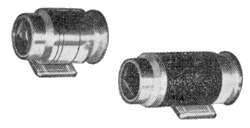 |
Viewfinders for 85mm, 90mm, 105mm, 135mm, and
150mm lenses were launched. They were direct-vision, non optical
types, and consisted of a cylinder with a three sixteenths of an
inch hole at one end to form the eyepiece, the other end
carrying a 2:3 proportional mask. |
The equivalent focal length of each view finder
depended upon the length of the cylinder. They were finished to
match the camera and fitted into the accessory shoe. The cost of
each viewfinder was £2.1s.8d.
A lens hood and filter holder was produced to fit onto
Lumar lenses. It was turned and polished to match the lens, and was
a press fit over the inner ring of the lens mount. The filter holder
screwed apart to accept standard 31mm filters. The price was
£1.6s.3d.
Another new product was a set of four well made
extension tubes, each with a Leica thread. They were made of metal
and finished in black. The sizes were 52mm, 34mm, 26mm, and 18mm.
They gave reductions of 1:1, 2:3, 1:2, and 1:3 respectively. The
price of the set was £2.17s.8d. There was also a separate 10mm tube
available for a 1:4 reduction, priced at 8s.11d.
 |
The focus adapter was developed to assist in
focusing and composing the exact field of view from a
lens. It was ideal to use in combination with the extension
tubes for close-up work. It consisted of a housing carrying a
ground glass screen and a lens flange. |
| Their separation distance was the
same as the film to flange distance in the Periflex camera.
In use the adapter was screwed into a tripod with the lens
fitted to it. The lens was focused and the adapter was
replaced by the camera, care being taken, of course, not to
disturb the focus setting or the tripod. It sold for
£2.17s.8d. |
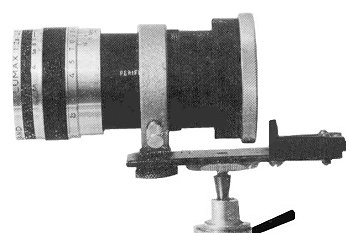
The focus adaptor in use with a 100mm Lumar and 10mm extension
tube. |
| The Corfield Microscope Adaptor allowed
microscope images to be photographed by a Periflex camera. It
had a built in focussing screen and a screw operated clamping
ring for attachment to a microscope. |
 |
The best selling Corfield product was the Periflex
camera. Its main competition was from Germany, but by 1956 German
camera prices were falling and so it was essential to redesign the
Periflex to ensure it retained its appeal.
In the new model, consideration was given to making
the camera easier to use, and John designed an automated periscope
mechanism. The periscope was automatically lowered each time the
film was advanced, and raised before the shutter fired. This greatly
increased the complexity of the mechanism, and meant that the camera
had to be taller to accommodate the extra mechanics. The taller body
also meant that an internal viewfinder could now be used. The new
periscope was completely housed inside the camera body, which had an
extra eye-level eyepiece on the back next to the one for the
viewfinder. Interchangeable objectives could be screwed onto the
front of the viewfinder to cater for lenses of different focal
lengths.
The top and bottom plates were given a finer, more
durable finish, and the film wind and shutter speed controls were
neater and easier to handle. Winding the shutter and transporting
the film were now a simultaneous function of the film wind-on
control, which also positioned the periscope. All of this was done
in just half a turn, making for a very rapid action. The film speed
dial was built around the rewind knob at the left end of the top
plate. The film speed as set by the dial could be viewed in a third
eyepiece that was just to the right of the other two. The rewind
knob pulled-up to rewind the film. X and M flash synchronisation
sockets were mounted on the front panel next to the viewfinder.
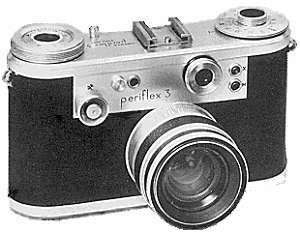 |
It was decided to retain the Periflex name as it
was so well known, and also to produce two versions, one cheaper
than the other. The cheaper version was to be called the
Periflex 2, and the more expensive version was to be the
Periflex 3. It was also decided, that it would be better to
regulate the rate of sales by releasing the more expensive
version first. Otherwise the initial demand for the cheaper
version alone could be too great for the company to handle. |
The Periflex 3 was to be released first, followed by
the Periflex 2 which would supercede the original camera.
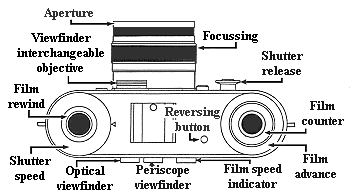 |
The view of a Periflex 3 from the top with the
controls labelled. |
The standard lens was a 4 element 45mm f2.8 Lumax. The
Lanthanum glass elements were made by Enna Werk in Germany to a very
high standard. One interesting feature is a very wide focus
adjustment which allows the lens to focus down to 12 inches, making
this a very early macro lens. Other Corfield lenses available for
the camera at this time were the 45mm f1.9 and the 35mm f3.5 Lumaxes,
the 50mm f3.5 Lumar-X, and the 100mm f4 Lumar.
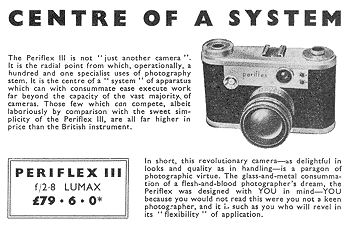 |
The camera was released in April 1957, and with
a 45mm f2.8 Lumax lens sold for £79.6s.0d. The 35mm lens, known
as the Retro-Lumax, cost £33.17s.6d. Additional viewfinder
objectives were £1.19s.6d each, except for the 35mm version
which was £2.15s.0d. A well designed ever ready case was also
available. |
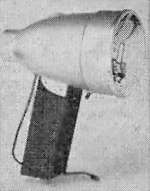 |
Also released at the same time was the Perilite
electronic flashgun. It was very compact and light in weight,
consisting of a flash head with an integral power supply housed
in the handle. |
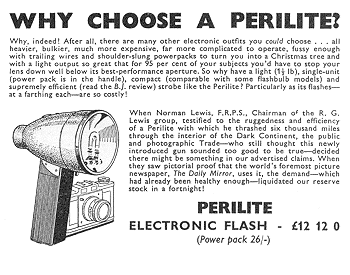 |
The power supply consisted of eight B.156
batteries which charged an internal 1000 micro farad capacitor
to 240 volts. The flash tube was a F.A.12 which gave a flash
duration of about 1/500 sec. The power output was 35 joules. A
set of batteries was quite expensive at 26 shillings, but this
would give a guaranteed 800 flashes. The flash weighed-in at one
and a half pounds and sold for £12.12s.0d. |
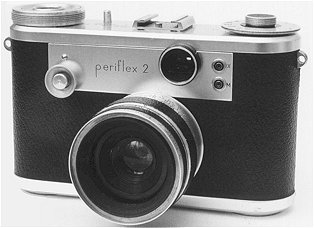 |
The Periflex 2 finally appeared in 1958. It
superceded the original Periflex, and was built to the same high
standard as the Periflex 3, with only minor differences. The
maximum shutter speed was 1/500 sec instead of 1/1000 sec, the
film speed indicator was removed, and the viewfinder objective
was fixed. Other viewfinders could be fitted into the accessory
shoe as on the original Periflex. |
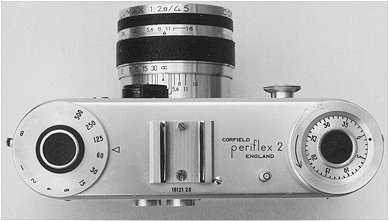 |
The camera top plate showing the clean styling.
The shutter speed dial and film rewind knob are on the left. The
film wind knob and film counter are on the right. |
| The Periflex 2 showing the
bottom of the automatically lowered and raised periscope. |
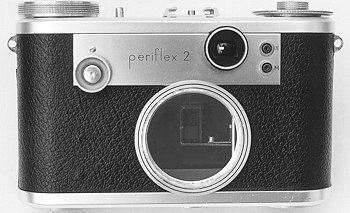 |
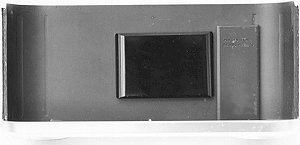 |
A Periflex back showing the patented glass film
pressure plate. |
| A Periflex 2 with its back cover removed. On the
right is the sprocket-less film drive which was a feature of all
Corfield cameras. |
 |
The camera, with a 45mm f3.5 Lumax lens sold for £23.
It was an instant success and orders poured in.
 |
|

|
|
 |
|
Back |
|
Return to
the contents
|
|
Continue |
|





































